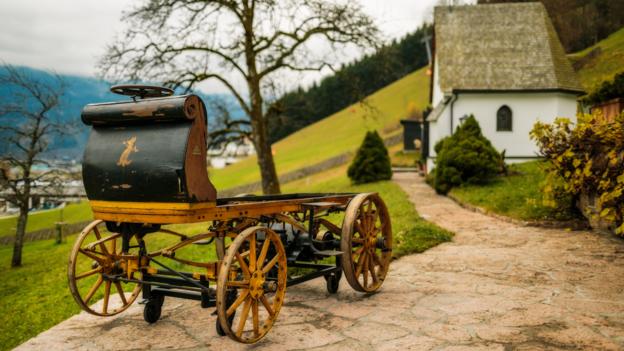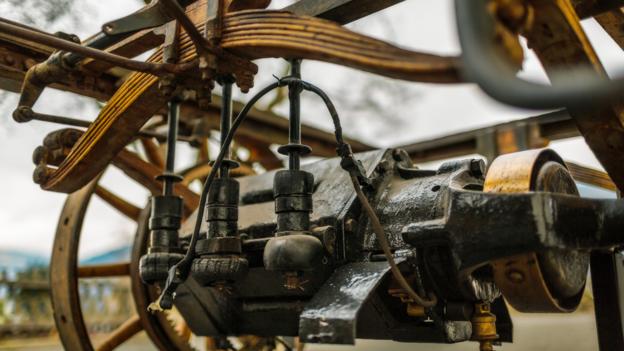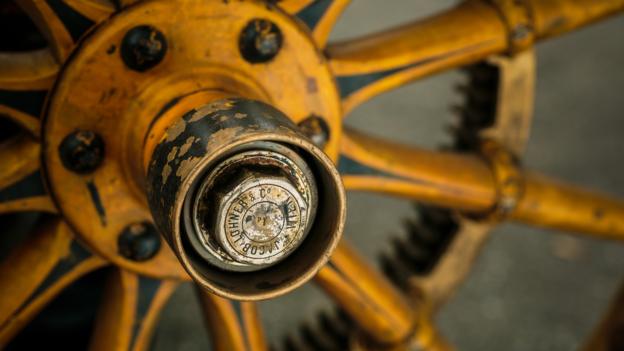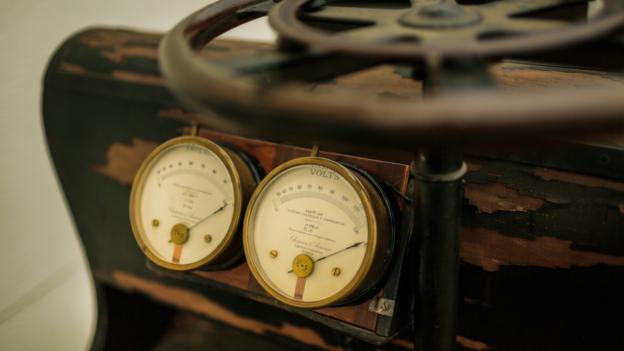P1, the unlikely Porsche pioneer
HIDE CAPTION
- Electric relic
- Porsche has affixed glass bodywork to the P1, so as to not obscure the car's mechanicals. (Porsche Cars)
Evidence of a young Ferdinand Porsche sowing wild oats has emerged. His
previously unknown automotive creation was discovered in an Austrian
warehouse – 111 years after he stored it there.
This new prologue to the German carmaker’s illustrious history stars
an ancient protagonist found in staggeringly good condition, a testament
to how well Porsche packed away this, his first-ever car, for
posterity’s sake.
Porsche built the car – really an electrically powered wagon – in 1898 at the request of Ludwig Lohner, then Austria’s leading coach builder. “He could already see the age of the horse soon would be over,” explained Dieter Landenberger, head of historical archives for the Porsche Museum in Stuttgart, Germany.
Lohner approached Porsche, an engineer for Austria’s Edison electric power subsidiary, and asked him to convert a Lohner carriage to electric power. The 22-year-old produced the P1, so-called because Porsche stamped his initial and the numeral on all the major components, to indicate this was his first car.
The P1 is propelled by a 287lb electric motor producing a nominal three horsepower. In “overboost” mode it can crank up the power to five steeds. The car’s gearbox features 12 ratios, including a reverse gear, and under full chatter Porsche estimates the P1 would have attained a top speed of 21mph.
The 1,000lb battery pack contained 44 cells, which produced 80 amps of 110-volt power for the motor. Appropriately for a Porsche – which, despite a concerted move towards the centre of the sport-luxury market, has retained some idiosyncrasies – the power switch to turn the P1 on is mounted to the left of the steering wheel. “It was already a true Porsche!” quipped Landenberger.
The 2,977lb car could drive 49 miles on a charge, comparable to the range of many of today’s purely electric wonders on a cold day. In 1899, Porsche entered the P1 in a 40km (24-mile) electric vehicle race in Berlin and won by a margin of 18 minutes against a field of competitors that saw more than half fail to finish.
The Porsche Museum is celebrating its fifth anniversary with the display of this ur-Porsche, which was discovered in 2013 by a classic car specialist in Austria. Landenberg said the finder requested anonymity, so the question of how one loses a Porsche in a warehouse that doesn’t also contain the Ark of the Covenant will go unanswered for the time being.
But Landenberger said the reason for it being packed away was obvious: Porsche already recognised its historical significance in 1902. That, he said, would explain his stamped initials on the car’s parts, and that’s why he would have left hand-written instructions on the driver’s seat for the car’s storage.
“I think Ferdinand Porsche was really proud of his construction,” Landenberger said. By the time the car was placed in storage in 1902, Porsche was pressing forward with more advanced projects, but he wanted to preserve his first effort.
Typically, early prototypes are either destroyed or recycled into subsequent improved versions, so few such cars tend to survive, Landenberger noted.
And the P1 was a keeper. Consider its advanced dual-circuit brake system. In addition to mechanical brakes acting on the rear wheel, the car also had electric brakes that could stop the car using the motor.
It also rolled on Dunlop pneumatic tires, unusual for the time. The tires were needed to cushion the ride because the P1’s Tudor batteries had fragile glass sides.
Porsche’s storage instructions for the P1 were clearly effective, as the car is almost perfectly preserved. “It was really in mint condition,” marvelled Landenberger. “It has some patina, you can see that, but it is amazingly good.”
In the state it was discovered, the car looked like little more than a rolling chassis, because the coachwork was absent. For the museum exhibit, Porsche has reconstructed its original bodywork from period photos, but fashioned it from glass so that the original parts are not obscured by a reproduction body.
Lohner carriages were built with bodywork mounted by six bolts so that owners could, for example, swap on enclosed coachwork for the winter. The P1’s coachwork was likely removed for use on another Lohner carriage, even one pulled by horses, Landenberger said.
The car was also stored without its batteries, but they were a simple design that would be easily duplicated if the car were ever to be driven. And its Dunlop tires have long since dry-rotted to oblivion. Porsche has commissioned a set of replacements from a vintage tire specialist in England, but it will be a year before the set is ready. “It is pretty difficult to get new tires,” Landenberger noted.
Such are the challenges – and joys – of meeting a long-lost relation for the first time.
Porsche built the car – really an electrically powered wagon – in 1898 at the request of Ludwig Lohner, then Austria’s leading coach builder. “He could already see the age of the horse soon would be over,” explained Dieter Landenberger, head of historical archives for the Porsche Museum in Stuttgart, Germany.
Lohner approached Porsche, an engineer for Austria’s Edison electric power subsidiary, and asked him to convert a Lohner carriage to electric power. The 22-year-old produced the P1, so-called because Porsche stamped his initial and the numeral on all the major components, to indicate this was his first car.
The P1 is propelled by a 287lb electric motor producing a nominal three horsepower. In “overboost” mode it can crank up the power to five steeds. The car’s gearbox features 12 ratios, including a reverse gear, and under full chatter Porsche estimates the P1 would have attained a top speed of 21mph.
The 1,000lb battery pack contained 44 cells, which produced 80 amps of 110-volt power for the motor. Appropriately for a Porsche – which, despite a concerted move towards the centre of the sport-luxury market, has retained some idiosyncrasies – the power switch to turn the P1 on is mounted to the left of the steering wheel. “It was already a true Porsche!” quipped Landenberger.
The 2,977lb car could drive 49 miles on a charge, comparable to the range of many of today’s purely electric wonders on a cold day. In 1899, Porsche entered the P1 in a 40km (24-mile) electric vehicle race in Berlin and won by a margin of 18 minutes against a field of competitors that saw more than half fail to finish.
The Porsche Museum is celebrating its fifth anniversary with the display of this ur-Porsche, which was discovered in 2013 by a classic car specialist in Austria. Landenberg said the finder requested anonymity, so the question of how one loses a Porsche in a warehouse that doesn’t also contain the Ark of the Covenant will go unanswered for the time being.
But Landenberger said the reason for it being packed away was obvious: Porsche already recognised its historical significance in 1902. That, he said, would explain his stamped initials on the car’s parts, and that’s why he would have left hand-written instructions on the driver’s seat for the car’s storage.
“I think Ferdinand Porsche was really proud of his construction,” Landenberger said. By the time the car was placed in storage in 1902, Porsche was pressing forward with more advanced projects, but he wanted to preserve his first effort.
Typically, early prototypes are either destroyed or recycled into subsequent improved versions, so few such cars tend to survive, Landenberger noted.
And the P1 was a keeper. Consider its advanced dual-circuit brake system. In addition to mechanical brakes acting on the rear wheel, the car also had electric brakes that could stop the car using the motor.
It also rolled on Dunlop pneumatic tires, unusual for the time. The tires were needed to cushion the ride because the P1’s Tudor batteries had fragile glass sides.
Porsche’s storage instructions for the P1 were clearly effective, as the car is almost perfectly preserved. “It was really in mint condition,” marvelled Landenberger. “It has some patina, you can see that, but it is amazingly good.”
In the state it was discovered, the car looked like little more than a rolling chassis, because the coachwork was absent. For the museum exhibit, Porsche has reconstructed its original bodywork from period photos, but fashioned it from glass so that the original parts are not obscured by a reproduction body.
Lohner carriages were built with bodywork mounted by six bolts so that owners could, for example, swap on enclosed coachwork for the winter. The P1’s coachwork was likely removed for use on another Lohner carriage, even one pulled by horses, Landenberger said.
The car was also stored without its batteries, but they were a simple design that would be easily duplicated if the car were ever to be driven. And its Dunlop tires have long since dry-rotted to oblivion. Porsche has commissioned a set of replacements from a vintage tire specialist in England, but it will be a year before the set is ready. “It is pretty difficult to get new tires,” Landenberger noted.
Such are the challenges – and joys – of meeting a long-lost relation for the first time.


















No comments:
Post a Comment